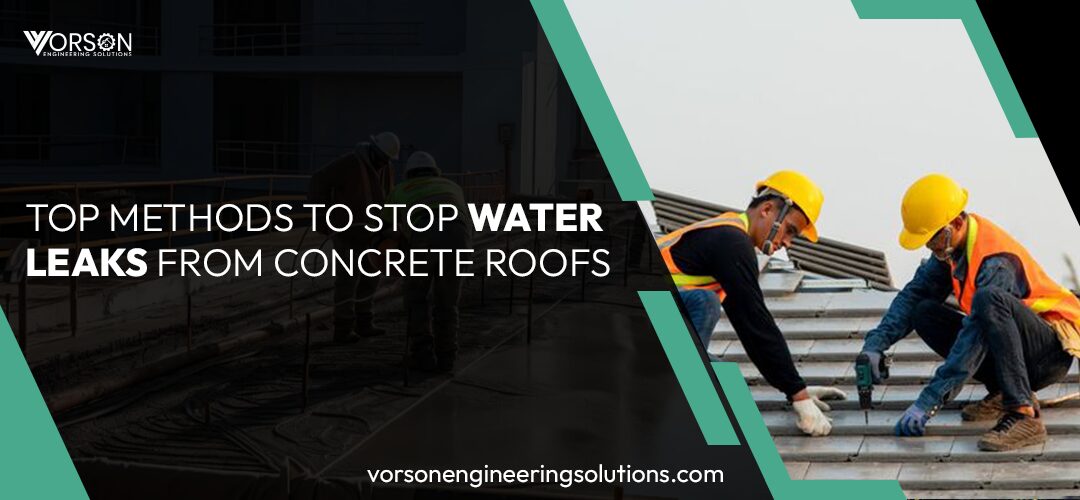Water leaks in concrete roofs can cause significant damage if not addressed promptly. Untreated leaks can have expensive and dangerous effects ranging from structural degradation to mold development. Maintaining the integrity of your house or structure depends on your knowing the best ways to find and stop water leaks. Using the most recent water leak detection technologies and efficient repair processes, we will investigate the best ways to stop water leaks from concrete roofs on this site. We will also discuss the need for electrical safety during repairs and issues of civil construction.
Building Water Leakage Solution
Concrete roofs are popular for their durability, but they are not immune to water infiltration. Factors including weathering, inadequate building techniques, and natural wear and tear over time can cause cracks and other roof weaknesses. Water seeping into these cracks can lead to several problems, including:
Structural Damage
Constant water intrusion can damage the concrete, resulting in fractures, spalling, and in severe circumstances even collapse.
Mold Growth
Moisture trapped inside the roof structure can encourage the growth of mold and mildew, therefore influencing interior air quality and creating health hazards.
Electrical Hazards
Water leaks can endanger electrical equipment installed in the ceiling or roof, therefore causing short circuits, fires, and other hazards.
Water Leak Detection Equipment
Modern water leak detection equipment has made it easier than ever to pinpoint the source of leaks in concrete roofs. Some of the most effective tools include:
Infrared Thermography
This non-invasive technique, infrared thermography, detects temperature changes on the roof surface using infrared cameras, therefore indicating moisture accumulation. Finding leaks invisible to the unaided eye is especially helped by infrared thermography.
Electronic Leak Detection (ELD)
ELD system’s electronic leak detection uses a tiny electrical current to identify leaks in the waterproof membrane of the roof. Any gaps let the current pass through, which lets experts precisely find leaks.
Moisture Meters
These moisture meters track the concrete’s moisture level, therefore pinpointing spots where water has seeped in. Determining the degree of the damage and choosing the best line of action depend on moisture meters.
Top Methods to Stop Water Leaks
It is imperative to solve the leak utilizing the most efficient repair techniques after the cause has been found. These are the excellent techniques to stop concrete roof water leaks:
Sealant Application
One of the easiest and most reasonably priced methods to stop leaks in concrete is to apply a premium sealer to seams and cracks. Because they are flexible, sealants can enable minor roof structural movement without cracking.
Membrane Waterproofing
Putting a waterproof membrane over the roof surface offers still another layer of defense against water seepage. Made from materials like bitumen, EPDM rubber, or PVC.
Polyurethane Foam Injection
Injection of polyurethane foam can be a good fit for more severe cracks or spots where water has seeped well into the concrete. The foam seals the crack and stops more leaks when it swells upon touch with water.
Cementitious Waterproofing
Applying a cement-based waterproof covering to the roof surface is a technique known as cementitious waterproofing. Long-term water leak prevention calls for cementitious coatings since they are strong and weatherproof.
Structural Repairs
More thorough repairs may be required in circumstances where the structural integrity of the roof has been damaged. This could call for adding new drainage systems, strengthening the roof with more concrete, or perhaps roof replacement in some areas.
Electrical Safety Considerations
Electrical safety is quite important while handling water leak detection on concrete rooftops. A risky mix is water and electricity; leaks might cause short circuits, fires, and other risks. These safety precautions should help you to be aware during maintenance operations:
Turn Off Power
Before beginning any repairs, be sure the electricity to the impacted area is shut off. This will lower fire risk and stop electrical shocks.
Inspect Electrical Systems
Have a licensed electrician check the roof’s electrical wiring and systems to make sure water exposure has not compromised them.
Use Waterproof Materials
Repair close to an electrical installation using waterproof sealants and insulation to guard the wire and equipment from potential leaks.
Civil Construction Practices for Preventing Leaks
Starting with good building techniques helps to prevent water leaks in concrete roofs. Following these civil building rules will help to lower the future leak risk while building or renovating a structure:
Proper Slope Design
Make sure the roof has a modest slope to guide water toward drainage points, therefore reducing surface pooling of water.
High-Quality Materials
For the concrete as well as the waterproofing layers, use strong, weather resistant materials.
Regular Maintenance
Plan frequent maintenance and inspections to find and fix possible problems before they become significant ones
Preventing Water Leaks in Concrete Roofing
A major issue of water leak detection in concrete roofing calls for quick care to stop more damage and guarantee the residents’ safety of the structure. Homeowners and building managers can efficiently control water leaks and safeguard their assets by using contemporary water leak detection technology, adhering to the highest standards in civil construction, and weighing electrical safety. Whether with basic sealant applications or more sophisticated membrane waterproofing, early actions now help prevent future hazards and expensive repairs.



